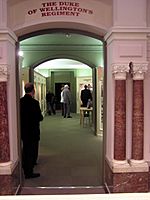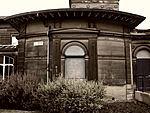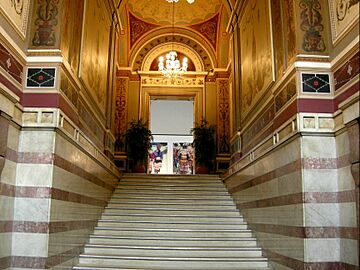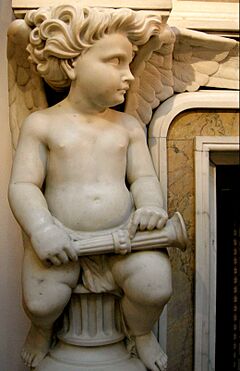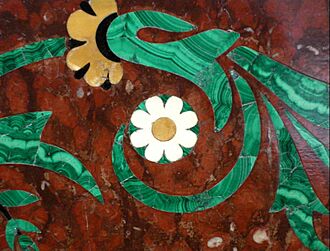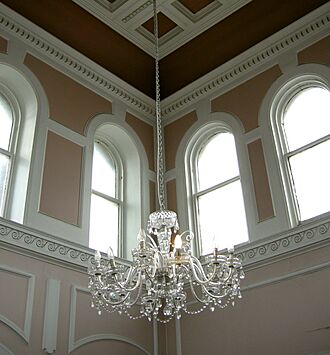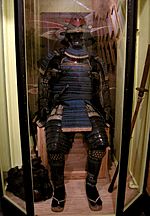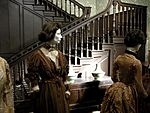Bankfield Museum facts for kids
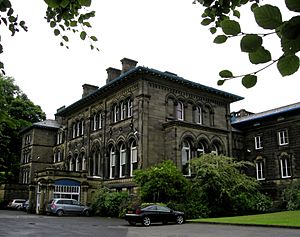
Bankfield Museum, Halifax, West Yorkshire
|
|
| Lua error in Module:Location_map at line 420: attempt to index field 'wikibase' (a nil value). | |
| Established | 1887 |
|---|---|
| Location | Boothtown Road, Halifax, West Yorkshire, England HX3 6HG |
| Type | Textiles gallery, Historic house museum, Regimental museum. |
| Public transit access | Halifax railway station First West Yorkshire (buses) Arriva Yorkshire (buses) Halifax Joint Committee (buses) |
Bankfield Museum is a special old house in Halifax, England. It's a "grade II listed building," which means it's an important historical place protected by law. This museum has a gallery about textiles (fabrics), and it also tells the story of a famous army regiment. The museum is known for its beautiful inside and for being owned by Colonel Edward Akroyd, a Member of Parliament.
Contents
Discovering Bankfield Museum's Past
When Edward Akroyd bought Bankfield in 1838, it was a much smaller house with only eight rooms. He was engaged to Elizabeth Fearby and worked with his brother for their rich father, Jonathan Akroyd, who owned a mill. After his father passed away in 1848, Edward used his inheritance to make Bankfield much bigger. He added new rooms, a dining room, a chapel, and kitchens. He also covered the old building with nice stone.
By 1867, Edward Akroyd was a Member of Parliament (MP) for Halifax. An MP is a person elected to represent their area in the country's government. Because he was an MP, he had to host many important guests. When the future King Edward VII visited Halifax in 1863, he had meals with the mayor. However, the prince did visit the Akroyd family's business. To impress important visitors, Edward Akroyd added a large new part to Bankfield in 1867. This new section had a grand entrance for carriages, a saloon, drawing rooms, a library, and a billiard room. At its busiest, the house needed 25 servants to help run it!
Edward Akroyd also built a special village nearby called Akroydon. It was a model village with Gothic-style houses, gardens, a shop, and a church. This showed how important the textile industry was in Victorian Britain.
By 1887, Edward Akroyd's business was not doing well, and he was very ill. He sold Bankfield to the town of Halifax for £6,000. The house quickly became a museum and a library. Over time, some of its original features were lost, but the building was protected in 1954. Today, it has been restored to look as much like its original self as possible. The local council believes Bankfield and Akroydon show how important the textile industry was to Victorian Britain. Some of the museum's collections, like natural history and archaeology, were moved to other museums. However, a large collection of textiles remains at Bankfield.
The Duke of Wellington's Regiment Museum
This part of Bankfield Museum tells the story of the famous "Havercake" regiment. The museum was updated in two stages, in 2005 and 2008, with help from the Heritage Lottery Fund. Lady Jane Wellesley, whose father was the 8th Duke of Wellington, reopened it.
The museum shows the regiment's history from 1702 until 2009. In 2009, the Duke of Wellington's Regiment joined with two other regiments to form the Yorkshire Regiment. You can learn about their history through stories from soldiers and interactive displays.
The regiment was made up of two older regiments, the 33rd and 76th Foot Regiments, which joined together in 1881. Arthur Wellesley, the 1st Duke of Wellington, was a colonel of the 33rd Regiment. The 76th Regiment served in India and carried special flags called "colours."
The main office and archives for the regiment are still in Halifax. Edward Akroyd helped create a local volunteer rifle group in 1860, which later became part of the Duke of Wellington's Regiment. He also supported having the regiment's main base in Halifax. Bankfield Museum helps with research and education about this important military history.
The regiment has fought in many battles throughout history. These include battles from 1743 all the way to the Iraq War in 2003. During the First and Second World Wars, soldiers from the regiment served in many roles, including tank crews and engineers. Since 1945, they have also served with the United Nations in different operations, including in Northern Ireland.
Exploring Bankfield Museum's Design
Outside the Museum
The museum building looks like an Italian house with its wide eaves and smooth stone. The main entrance used to be an open area where carriages could drive under a stone roof for people to get out. This was called a "porte-cochere."
The building has an interesting shape because of all the parts added over time. It has two levels with arches above a basement, especially in the part built in 1867. The roof is slanted and made of slate, and the whole design looks like Italian buildings from the 14th and 15th centuries. The basement has a rough stone finish. From the back, you can see a low tower that lets light into the back staircase. The arched walkways, which were once open, are now enclosed.
Inside the Museum
The grand staircase is made of marble. Its decorations are inspired by ancient Roman paintings found in Pompeii and Herculaneum. The design at the bottom of the stairs even looks like ancient Egyptian art. The dining room is now used for temporary exhibitions. It has a beautiful marble fireplace and a plaster design showing the royal coat of arms. The Regimental Museum is located in what used to be the drawing room suite. Below the library was the billiard room, which you could reach from the bottom of the staircase. The 1867 part of the building had special grilles in the baseboards for warm air, likely from a boiler. There's even a story that hot air came from the nearby Haley Mill! The floors in the marble gallery and chapel lobby have colorful tiles made by Maw & Co.
The Saloon
This large room is now the museum's entrance hall and shop. Its walls are used to display temporary exhibitions. The saloon was once a grand hall, reception room, art gallery, and ballroom. It had very little furniture, many oil paintings, and gas chandeliers. The ceiling has skylights with painted plaster decorations in a classical style. The marble fireplace features two large marble figures of "putti," which are small, chubby angels. Putti are also a main feature on the grand staircase ceiling.
The Library
This room is now the World of Textiles gallery. The exhibits are displayed in the original oak bookcases. It was a very bright room with three large windows on both the north and east walls. The ceiling had fittings for three chandeliers. The top parts of the windows have etched glass with designs that match the patterns on the ceiling. One of the bookcases displays silver items made by Charles Horner, a jeweler from Halifax.
Library Ceiling Art
The library was also used as a smoking room, so it's amazing that the original painted ceiling survived and could be fully restored. The ceiling is richly painted, gilded, and sculpted. Its design comes from classical art. The background is cream, but there's a lot of "Pompeian red," a color that became popular in Victorian England after new discoveries in Pompeii in 1860. Small panels show classical designs and portraits that look like old frescoes. Four round pictures show famous poets: Shakespeare, Milton, Chaucer, and Tennyson. All the spaces on the cream background are filled with illustrations that look like old Italian pottery. They feature goats, fauns (mythical creatures, half-human, half-goat), cornucopias (horns of plenty), grapes, birds, and flowers. There are also angels and putti in the center. The decoration around the edge includes a "Green Man," a face made of leaves.
Library Fireplace
The fireplace is made of red marble with cream and black marble. It has patterns made with inlaid semi-precious stones, including green malachite. All these materials were imported. The intertwined initials of Edward and Elizabeth Akroyd are in the center of the fireplace, which is clearly dated 1867. The inlay also features the White Rose of Yorkshire, possibly made of Parian marble. This rose design is repeated on the carved columns of the fireplace. The mantelpiece is very large and holds three life-sized marble statues: Edward Akroyd, his father Jonathan, and his wife Elizabeth Fearby. The statue of Elizabeth is special because it looks like she has a veil over her face. The tiles in the hearth (the area in front of the fireplace) are similar to Mintons tiles but were probably made locally.
Back Staircase
On the wall of the stairwell, there are plaster sculptures of Night and Day. These are based on works by a Danish sculptor named Bertel Thorvaldsen. They are meant to show the division between the sleeping areas upstairs and the living areas downstairs. The oak banister has turned wooden balusters and brass decorations shaped like lions. This is because Elizabeth Akroyd's family crest featured lions. The ceiling has many recessed panels, and there are windows all around the top of the stairwell. A large glass chandelier hangs there, making the area very bright. The stairwell is built as a separate tower to allow for so many windows.
People Connected to the Museum
The Halifax Literary and Philosophical Society was started in 1830 by 13 local people. They wanted to research and study, promote science and arts, and create a museum for their collections. These collections included interesting items from their travels, such as objects related to geology, natural history, and art. Their museum was successful at first but closed in 1895. The exhibits were then given to Halifax museums. Some of Bankfield's share has survived and is displayed to show what Victorians found interesting.
Lemuel Clayton was a local council member and silk spinner. He was one of the people who helped start Bankfield Museum in 1887. He was part of the Literary and Philosophical Society and had traveled the world, collecting many interesting items. These items were some of the first things shown in the museum. One of them was a stone carving of a baby that he got in 1886 from a temple in Kyoto, Japan. It was unusual for him to take such an item, but he convinced the temple leader to let him have it. So, in 1887, another baby image was added to Bankfield House, the same year Edward Akroyd died and while his wife Elizabeth, who had no children, was still alive.
Emile Clement (1844–1928) gave or sold some of his collection of Australian Aboriginal items to the museum. This collection was later moved to Manchester Museum.
Henry Ling Roth was an anthropologist and the curator of the Halifax museums from 1900 to 1925. An anthropologist studies human societies and cultures. He wrote many articles about anthropology. He is known as "The man who developed a small, confused, unattractive museum into an important centre of spectacular interest and research." Before him, the museum displayed items like a "cabinet of curiosities." But Roth organized the displays to teach people about different cultures and times. He was very interested in textiles and displayed textile machines from the area, as well as spinning wheels, looms, and textiles from other parts of the world. He was praised for this work in 1916.
Edith Durham was an anthropologist and collected textiles from the Balkans (a region in Southeast Europe). She gave her collection to the museum in 1935. It's thought that the museum received this important collection because of the good reputation Henry Ling Roth had built for Bankfield.
Events and Activities
The museum often hosts temporary exhibitions. For example, in 2009, there was an exhibition of textiles inspired by Chinese art. Bankfield Museum also has regular events, including talks for the public. They offer workshops and activities for children, as well as educational programs for schools.
See Also
- Listed buildings in Halifax, West Yorkshire



